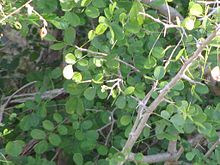| African blackwood | |
|---|---|

| |
| Scientific classification | |
| Kingdom: | Plantae |
| Clade: | Tracheophytes |
| Clade: | Angiosperms |
| Clade: | Eudicots |
| Clade: | Rosids |
| Order: | Fabales |
| Family: | Fabaceae |
| Subfamily: | Faboideae |
| Genus: | Dalbergia |
| Species: | D. melanoxylon
|
| Binomial name | |
| Dalbergia melanoxylon | |
| Synonyms[2] | |
| |
Dalbergia melanoxylon (African blackwood, grenadilla, or mpingo) in french Granadille d'Afrique is a flowering plant in the family Fabaceae, native to seasonally dry regions of Africa from Senegal east to Eritrea, to southern regions of Tanzania to Mozambique and south to the north-eastern parts of South Africa. The tree is an important timber species in its native areas; it is used in the manufacture of musical instruments,[3] sculptures vinyago in Swahili language and fine furnitures. Populations and genomic resources for genetic biodiversity maintenance in parts of its native range are threatened by overharvesting due to poor or absent conservation planning and by the species' low germination rates.[3]
African blackwood is a small tree, reaching 4–15 m tall, with grey bark and spiny shoots. The leaves are deciduous in the dry season, alternate, 6–22 cm long, pinnately compound, with 6–9 alternately arranged leaflets. The flowers are white and produced in dense clusters. The fruit is a pod 3–7 cm long, containing one to two seeds. It is often cited as one of the most expensive woods in the world.
- ^ Barstow, M. (2020). "Dalbergia melanoxylon". IUCN Red List of Threatened Species. 2020: e.T32504A67798379. doi:10.2305/IUCN.UK.2020-3.RLTS.T32504A67798379.en. Retrieved 19 November 2021.
- ^ The Plant List: A Working List of All Plant Species, retrieved 12 December 2015
- ^ a b Amri, E.; Z.L. Kanyeka; H.V.M. Lyaruu; A.S. Nyomora (2009). "Evaluation of genetic diversity in Dalbergia elanoxylon populations using random amplified polymorphic DNA markers". Research Journal of Cell and Molecular Biology. 3 (2). INSInet Publication: 71–79.
